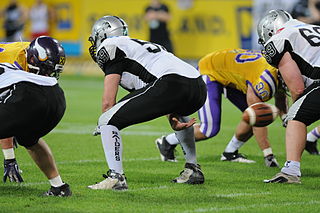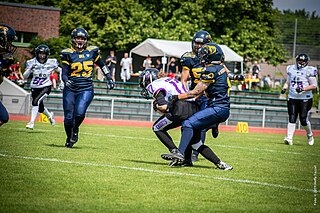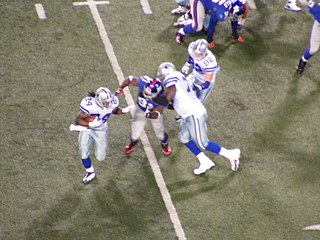
Offside is a minor foul in gridiron football caused when a player crosses the line of scrimmage ahead of the snap of the ball. The penalty associated with the infraction is the advancing of the ball five yards and a replay of the down.

Offside is a minor foul in gridiron football caused when a player crosses the line of scrimmage ahead of the snap of the ball. The penalty associated with the infraction is the advancing of the ball five yards and a replay of the down.
In gridiron football, offside is a foul in which a player is on the wrong side of the line of scrimmage when the ball is snapped. The foul occurs simultaneously with the snap.
Offside is committed by the defense when a defensive player crosses the line of scrimmage before the ball is snapped. In the case of an offside foul, play is not stopped, and the foul is announced at the conclusion of the play, giving the offense a free play because the non-offending team can choose whether to accept the result of the play or accept the five yards gained by the penalty.
Although an offside foul is usually committed by the defense, if an offensive player lines up in the neutral zone, an offside foul will be called against the offense. An offside foul will also be called if the ball snapper advances past the neutral zone before snapping the ball. [1]
In high school games played under the NFHS ruleset, the term "offside" is not used; rather the foul is referred to as encroachment and causes the ball to remain dead. However, the penalty remains five yards, the same as other rule codes.
Prior to 1925, a call of offside against a defensive unit brought with it an automatic first down in addition to a five-yard advancement of the ball for the offense. [2] However, a December 1924 meeting of the Football Coaches' Association of America spurred a change of rules for the 1925 season eliminating the provision for an automatic first down, while leaving the five yard penalty intact. [2]
The penalty for violation remains five yards at most levels of professional and amateur play.

Canadian football, or simply football, is a sport in Canada in which two teams of 12 players each compete on a field 110 yards (101 m) long and 65 yards (59 m) wide, attempting to advance a pointed oval-shaped ball into the opposing team's end zone.
In gridiron football, not all players on offense are entitled to receive a forward pass: only an eligible pass receiver may legally catch a forward pass, and only an eligible receiver may advance beyond the neutral zone if a forward pass crosses into the neutral zone. If the pass is received by a non-eligible receiver, it is "illegal touching". If an ineligible receiver is beyond the neutral zone when a forward pass crossing the neutral zone is thrown, a foul of "ineligible receiver downfield" is called. Each league has slightly different rules regarding who is considered an eligible receiver.

A snap is the backward passing of the ball in gridiron football at the start of play from scrimmage.

In gridiron football, a line of scrimmage is an imaginary transverse line beyond which a team cannot cross until the next play has begun. Its location is based on the spot where the ball is placed after the end of the most recent play and following the assessment of any penalty yards.

Gridiron football, also known as North American football, or in North America as simply football, is a family of football team sports primarily played in the United States and Canada. American football, which uses 11 players, is the form played in the United States and the best known form of gridiron football worldwide, while Canadian football, which uses 12 players, predominates in Canada. Other derivative varieties include arena football, flag football and amateur games such as touch and street football. Football is played at professional, collegiate, high school, semi-professional, and amateur levels.

A down is a period in which a play transpires in gridiron football. The down is a distinguishing characteristic of the game compared to other codes of football, but is synonymous with a "tackle" in rugby league. The team in possession of the football has a limited number of downs to advance ten yards or more towards their opponent's goal line. If they fail to advance that far, possession of the ball is turned over to the other team. In most situations, if a team reaches their final down they will punt to their opponent, which forces their opponent to begin their drive from further down the field; if they are in range, they might instead attempt to score a field goal.
This is a glossary of terms used in Canadian football. The Glossary of American football article also covers many terms that are also used in the Canadian version of the game.

American and Canadian football are gridiron codes of football that are very similar; both have their origins partly in rugby football, but some key differences exist between the two codes.
In American and Canadian gridiron football, pass interference (PI) is a foul that occurs when a player interferes with an eligible receiver's ability to make a fair attempt to catch a forward pass. Pass interference may include tripping, pushing, pulling, or cutting in front of the receiver, covering the receiver's face, or pulling on the receiver's hands or arms. It does not include catching or batting the ball before it reaches the receiver. Once the ball touches any defensive player or eligible offensive receiver, the above rules no longer apply and the defender may tackle the receiver or attempt to prevent them from gaining control of the ball. Once a forward pass is in the air it is a loose ball and thus any eligible receiver – all defensive players are eligible receivers – may try to catch it. When a defensive player catches a forward pass it is an interception and their team gains possession of the ball. Some actions that are defined as pass interference may be overlooked if the defender is attempting to catch or bat the ball rather than focusing on the receiver.

Gameplay in American football consists of a series of downs, individual plays of short duration, outside of which the ball is dead or not in play. These can be plays from scrimmage – passes, runs, punts or field goal attempts – or free kicks such as kickoffs and fair catch kicks. Substitutions can be made between downs, which allows for a great deal of specialization as coaches choose the players best suited for each particular situation. During a play, each team should have no more than 11 players on the field, and each of them has specific tasks assigned for that specific play.
A formation in American football refers to the position players line up in before the start of a down. There are both offensive and defensive formations and there are many formations in both categories. Sometimes, formations are referred to as packages.
In gridiron football, intentional grounding is a violation of the rules where "a passer...throws a forward pass without a realistic chance of completion." This typically happens when a quarterback about to be sacked passes the ball toward an area of the field with no eligible receiver. Without this rule, the quarterback could almost always avoid a sack by intentionally throwing an incomplete pass ; instead, the penalty of intentional grounding effectively continues play as if the defense had succeeded in sacking the quarterback.

In gridiron football, motion refers to the movement of an offensive player at the time of the snap.
The following terms are used in American football, both conventional and indoor. Some of these terms are also in use in Canadian football; for a list of terms unique to that code, see Glossary of Canadian football.

In gridiron football, a penalty is a sanction assessed against a team for a violation of the rules, called a foul. Officials initially signal penalties by tossing a bright yellow colored penalty flag onto the field toward or at the spot of a foul.

In gridiron football, holding is the illegal use of the hand or arm to restrain another player who is not in possession of the ball. Holding is prohibited in most football leagues because it does not allow fair play of the game and increases the risk for injury. It is one of the most common penalties in American football.

In gridiron football, a punt is a kick performed by dropping the ball from the hands and then kicking the ball before it hits the ground. The most common use of this tactic is to punt the ball downfield to the opposing team, usually on the final down, with the hope of giving the receiving team a field position that is more advantageous to the kicking team when possession changes. The result of a typical punt, barring any penalties or extraordinary circumstances, is a first down for the receiving team. A punt is not to be confused with a drop kick, a kick after the ball hits the ground, now rare in both American and Canadian football.
In gridiron football, there are several different rulings for encroachment:

A hard count by a quarterback at the beginning of a gridiron football play is an audible snap count that uses an irregular, accented cadence. When used, the center will hike the ball to the quarterback on an accented syllable.